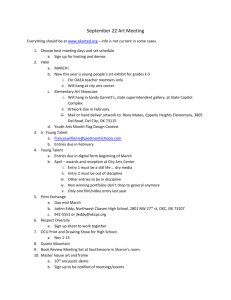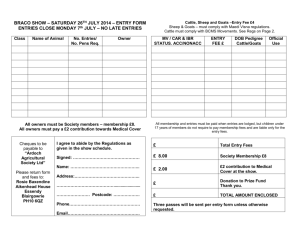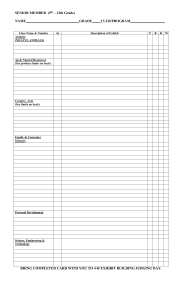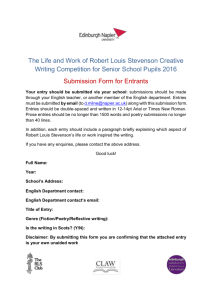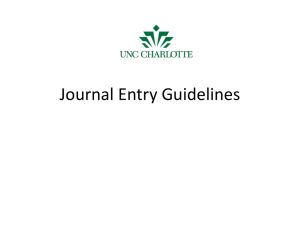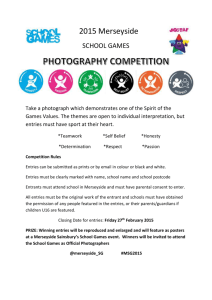Journal Rubric - The Webster Web
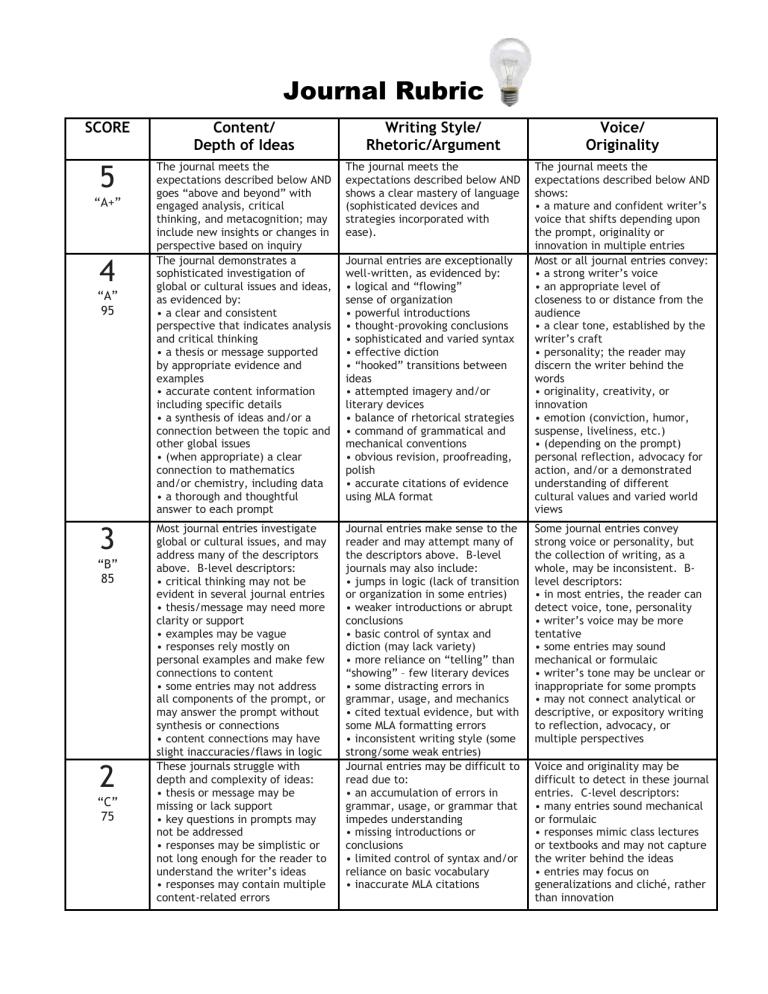
SCORE
5
“A+”
4
“A”
95
3
“B”
85
2
“C”
75
Journal Rubric
Content/
Depth of Ideas
The journal meets the expectations described below AND goes “above and beyond” with engaged analysis, critical thinking, and metacognition; may include new insights or changes in perspective based on inquiry
The journal demonstrates a sophisticated investigation of global or cultural issues and ideas, as evidenced by:
• a clear and consistent perspective that indicates analysis and critical thinking
• a thesis or message supported by appropriate evidence and examples
• accurate content information including specific details
• a synthesis of ideas and/or a connection between the topic and other global issues
• (when appropriate) a clear connection to mathematics and/or chemistry, including data
• a thorough and thoughtful answer to each prompt
Most journal entries investigate global or cultural issues, and may address many of the descriptors above. B-level descriptors:
• critical thinking may not be evident in several journal entries
• thesis/message may need more clarity or support
• examples may be vague
• responses rely mostly on personal examples and make few connections to content
• some entries may not address all components of the prompt, or may answer the prompt without synthesis or connections
• content connections may have slight inaccuracies/flaws in logic
These journals struggle with depth and complexity of ideas:
• thesis or message may be missing or lack support
• key questions in prompts may not be addressed
• responses may be simplistic or not long enough for the reader to understand the writer’s ideas
• responses may contain multiple content-related errors
Writing Style/
Rhetoric/Argument
The journal meets the expectations described below AND shows a clear mastery of language
(sophisticated devices and strategies incorporated with ease).
Journal entries are exceptionally well-written, as evidenced by:
• logical and “flowing” sense of organization
• powerful introductions
• thought-provoking conclusions
• sophisticated and varied syntax
• effective diction
• “hooked” transitions between ideas
• attempted imagery and/or literary devices
• balance of rhetorical strategies
• command of grammatical and mechanical conventions
• obvious revision, proofreading, polish
• accurate citations of evidence using MLA format
Journal entries make sense to the reader and may attempt many of the descriptors above. B-level journals may also include:
• jumps in logic (lack of transition or organization in some entries)
• weaker introductions or abrupt conclusions
• basic control of syntax and diction (may lack variety)
• more reliance on “telling” than
“showing” – few literary devices
• some distracting errors in grammar, usage, and mechanics
• cited textual evidence, but with some MLA formatting errors
• inconsistent writing style (some strong/some weak entries)
Journal entries may be difficult to read due to:
• an accumulation of errors in grammar, usage, or grammar that impedes understanding
• missing introductions or conclusions
• limited control of syntax and/or reliance on basic vocabulary
• inaccurate MLA citations
Voice/
Originality
The journal meets the expectations described below AND shows:
• a mature and confident writer’s voice that shifts depending upon the prompt, originality or innovation in multiple entries
Most or all journal entries convey:
• a strong writer’s voice
• an appropriate level of closeness to or distance from the audience
• a clear tone, established by the writer’s craft
• personality; the reader may discern the writer behind the words
• originality, creativity, or innovation
• emotion (conviction, humor, suspense, liveliness, etc.)
• (depending on the prompt) personal reflection, advocacy for action, and/or a demonstrated understanding of different cultural values and varied world views
Some journal entries convey strong voice or personality, but the collection of writing, as a whole, may be inconsistent. Blevel descriptors:
• in most entries, the reader can detect voice, tone, personality
• writer’s voice may be more tentative
• some entries may sound mechanical or formulaic
• writer’s tone may be unclear or inappropriate for some prompts
• may not connect analytical or descriptive, or expository writing to reflection, advocacy, or multiple perspectives
Voice and originality may be difficult to detect in these journal entries. C-level descriptors:
• many entries sound mechanical or formulaic
• responses mimic class lectures or textbooks and may not capture the writer behind the ideas
• entries may focus on generalizations and cliché, rather than innovation
1
“F”
SCORE
5
“A+”
4
“A”
95
3
“B”
85
2
“C”
75
1
50
Note: If you make an honest attempt to complete all journal entries, you will not fail. Simple as that. The only journals that receive failing grades are those that are missing entries or those that have copied/plagiarized others’ ideas. Each missing entry = a 10 point deduction. Plagiarism on any section of the journal will result in a zero for the entire journal grade.
Typical Comments
___ Above and beyond – excellent risk-taking with an amazing result.
___ Wow! Mind-blowing! I want to BE you.
___ Please share your ________________________________ journal with others.
___ Your journal represents a collection of interesting ideas, strong voice, and skilled writing.
___ Many of your entries are insightful, thought-provoking, or attention-grabbing.
___ You are a great storyteller – nice incorporation of devices (details, imagery, metaphor, etc.)
___ Your journal entries go beyond the textbook or class lectures to convey new knowledge or ideas.
___ Excellent self-analysis of creative or artistic entries.
-----------------------------------------------------------------------------------------------------------------------------------
(A-) ___ Your journal is strong in two categories (depth of ideas, writing style, or voice), but one
category needs to be further developed.
___ Proofreading errors indicate a lack of polish; spend more time on the writing process.
(B+) ___ Your journal is very strong in one category (depth of ideas, writing style, or voice), but two
categories need to be further developed.
-----------------------------------------------------------------------------------------------------------------------------------
___ Dig deeper – you are on the right track, but some of your entries are “surface level” responses.
___ Provide more evidence to back up your ideas (prove your assertions).
___ Go beyond the textbook, class lectures, and basic internet searches to convey your insights.
___ Focus on diction and tone to develop your voice as a writer (some entries may sound robotic).
___ Spend more time crafting introductions so that you grab the reader’s attention.
___ Examples are vague or general – give the reader specifics.
___ Journal entries end abruptly – bring closure to your reader/leave them thinking at the end.
___ Remove “I think,” “I believe,” or “I feel” statements – this weakens your stance.
___ Avoid unnecessary wordiness – there is beauty in simplicity, at times.
___ Avoid 2 nd person (you) – it sounds preachy.
___ Avoid 1 st person (I, me) in academic or analytical writing.
___ Focus attention on syntax (avoid run-ons and fragments; properly punctuate sentences.)
___ Eliminate unnecessary repetition (consider first word revision strategies).
___ Most examples are from your personal experience; include evidence from other sources, too.
___ Most examples are from other sources; include personal reflection, too.
___ Some entries include a “laundry list” of facts – connect content information with analysis.
___ Author’s notes (for poems) and/or artist’s notes (for artistic entries) need to be expanded.
___ Sources are cited, but MLA format may be inaccurate.
___ Book titles should be underlined or italicized; short stories and articles should be in quotation marks.
___ Multiple writing errors detract from the great ideas you are trying to share.
___ Dig deeper – you are on the right track with some entries, but many of your entries are incomplete.
___ Multiple comments from above may apply – journals show very little revision or proofreading.
___ Expand your entries – you may not have provided enough writing for the reader to find meaning.
___ Spend more time on revision – many of your entries lack organization (jump from topic to topic with
no transition between ideas.
___ Spend more time on mechanics/grammar/usage – multiple errors make your work difficult to read.
(Consider a writing conference before you turn in your next set of journals.)
This journal is incomplete. Plan to attend tutorials during the next grading period so you can work on drafts early and benefit from writing conferences.
15 = 100
14 = 98
13 = 96
12 = 95
11 = 90
10 = 88
9 = 85
8 = 80
7 = 78
6 = 75


